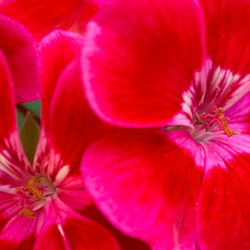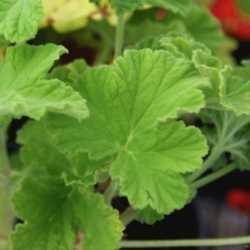Scented geraniums (Pelargonium graveolens) are tender perennials, hardy to about 30°F. I grow them in pots, so they can be easily brought in for the winter. Of course, if you live in zone 8 or warmer, you can enjoy them in your garden year round.  With pruning, they can be kept in a six or eight inch pot, but they will grow with abandon in a pot of twelve inches or more in size. Most varieties are upright, but some have a more trailing or compact habit. They appreciate good drainage, so they do well in containers or in raised beds. They'll grow best in full sun, but any spot with a few hours of late morning or afternoon sun will work.
With pruning, they can be kept in a six or eight inch pot, but they will grow with abandon in a pot of twelve inches or more in size. Most varieties are upright, but some have a more trailing or compact habit. They appreciate good drainage, so they do well in containers or in raised beds. They'll grow best in full sun, but any spot with a few hours of late morning or afternoon sun will work.
These plants originate in Africa, and I had a chance to see a remarkable collection of species types at the Hortus Botanicus in Amsterdam. If you're used to bedding geraniums, you won't believe the size of these plants. They can grow to three feet or more in height, and the leaves of some are as large as my outstretched hand. Some of the larger varieties can be trained to a single-stem topiary form, for a striking effect. Over the years, they've been selected for fragrance, leaf form, plant habit, and bloom color, producing a remarkable selection of cultivars.
The variety of fragrance and foliage among scented geranium cultivars is astounding. From strong scents of lemon, rose, or mint to softer scents of spice and sweet fruit, there's a scent to suit every nose! For pure, sweet old rose fragrance, my favorite is ‘Attar of Roses', but some prefer the pungent musk of ‘Skeleton Rose', with its intricate leaves. Several varieties have pungent lemon scents, with slight variations. ‘Citronella' and 'Rober's Lemon Rose' smell just as you'd expect, while ‘Lady Grey' has a bright citrus smell like Lemon Pledge™. ‘Chocolate Mint' and ‘Peppermint Rose' both have a clean minty fragrance, but their foliage couldn't be more different in shape or texture.
 |
 |
 |
As with other herbs, the fragrance of the foliage is released when you rub a leaf or run your hand over the plant. Place these plants where you'll be sure to brush against them regularly.  They do well as single specimen pots, but I like to grow two or more complementary varieties in a large pot. I look for fun name combinations such as ‘Lime' with ‘Coconut' or ‘Apple' with ‘Cinnamon'. Both those combinations smell great together and offer the contrast of a crisp-leafed upright variety with a softer looking mounding or trailing plant. If you're looking for more compact varieties, try a sweet and spicy combination of ‘Cody's Wild Nutmeg' with ‘Peach' or ‘Strawberry'.
They do well as single specimen pots, but I like to grow two or more complementary varieties in a large pot. I look for fun name combinations such as ‘Lime' with ‘Coconut' or ‘Apple' with ‘Cinnamon'. Both those combinations smell great together and offer the contrast of a crisp-leafed upright variety with a softer looking mounding or trailing plant. If you're looking for more compact varieties, try a sweet and spicy combination of ‘Cody's Wild Nutmeg' with ‘Peach' or ‘Strawberry'.
Scented geraniums also add wonderful foliage and fragrance to a mixed container.  Annuals such as basils or fresh-faced violas tuck in nicely around the edges of a potted pelargonium. This year, I planted colorful oxalis around the edges of my scented geranium pots. I won't need to lift the tender oxalis tubers in fall; they can simply come inside with the rest of the pot.
Annuals such as basils or fresh-faced violas tuck in nicely around the edges of a potted pelargonium. This year, I planted colorful oxalis around the edges of my scented geranium pots. I won't need to lift the tender oxalis tubers in fall; they can simply come inside with the rest of the pot.  Likewise, if there's a tender lavender or non-hardy thyme you've wanted to try, tuck it in with a pelargonium and bring them all in together before frost.
Likewise, if there's a tender lavender or non-hardy thyme you've wanted to try, tuck it in with a pelargonium and bring them all in together before frost.
As with other herbs, scented geraniums should be pinched back regularly. The larger varieties, in particular, tend to get leggy. Regular pinching encourages branching and makes a prettier plant. If a plant gets out of control, don't be afraid to prune it back pretty hard, leaving just a few new shoots near the base. The stems can get pretty tough, so scissors will work better than fingernails.
 |
 |
 |
What to do with those piles of lovely, scented leaves you've pruned off your plants? Dry them for potpourri or sachets! The dried leaves keep their scent for a long time, releasing a burst of fragrance any time you stir them up. I usually snip off the stems, but you could leave them on for a chunkier potpourri, maybe adding some dried orange peels or cinnamon sticks. A dear friend never let me throw away a single scented leaf when she lived next door; she collected all my snippings into a big fragrant bowl for her formal living room.
If you're thinking some of them smell good enough to eat, you're right!
The easiest way to get a touch of geranium into your cooking is to flavor sugar with the essential oils in the leaves. Layer fresh or dried leaves in a jar with granulated sugar, and let it sit for a week or so. When you sift out the leaves, you'll find the sugar has picked up a lovely flavor and scent. Imagine sprinkling rose geranium sugar on a little lemon cookie, or topping a tea cake with sugar flavored with spice-scented geraniums. You can also experiment with chopping a few fresh leaves into a fruit salad or adding them to an herbal tea.
What if you don't have sunny window space for an assortment of 12 inch pots over the winter? No need to build a greenhouse (at least not for that). You can take cuttings in fall and over-winter them in 4 inch pots on your windowsill or on a light shelf. Even a single small plant can add a breath of spring sweetness to a winter-grey room. Just rub a leaf or run your hand over the plant to release the fragrance. On days when I water the scented geranium pots in my sun room, the scent fills the whole house.
Scented geraniums are a wonderful way to bring the best scents of the rose garden and herb bed to your indoor and outdoor containers, all year round! They're easy to propagate, so you can build a collection of favorites by sharing and trading. Whether you love pungent mint and citronella or whether you favor sweeter scents of fruit and spice, you'll find a Pelargonium to absolutely fall in love with. And did I mention? They have pretty flowers, too!
 |
 |
 |
Photos by Jill M. Nicolaus. Move your mouse over images and links for additional information (let the cursor hover for a few seconds, and a popup caption will appear).
Thanks to Sandy Mush Herb Nursery, for first introducing me to scented geraniums many years ago, and to DeBaggio's Herb Nursery, for supplying my Pelargonium habit!

















